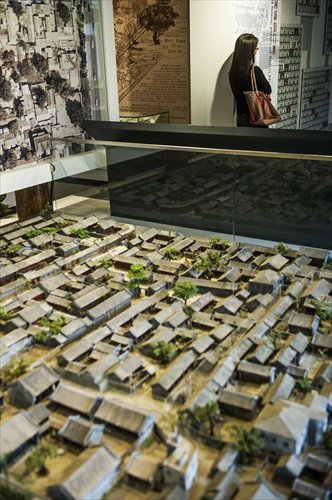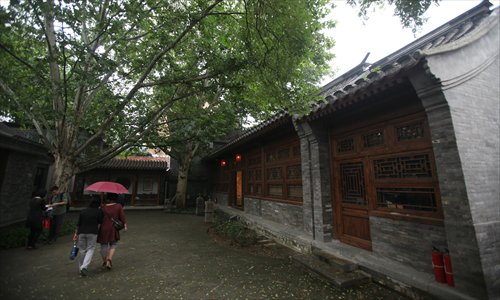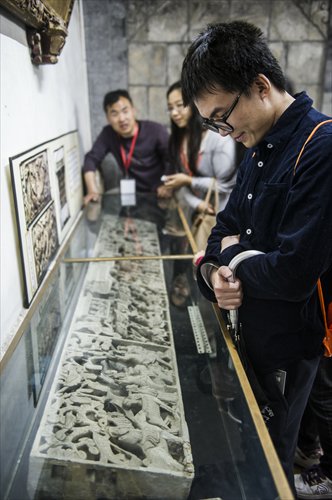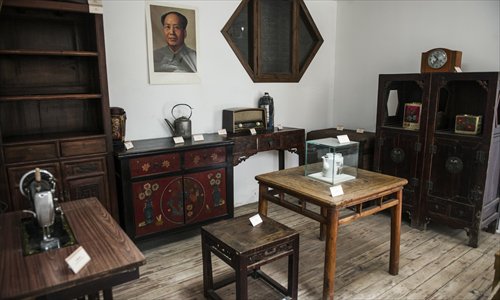Courtyard of memories

A model at Shijia Hutong Museum gives visitors a sense of the scope of Beijing's once vast hutong network. Photo: Li Hao/GT
Shijia Hutong Museum might only be six months old, but inside it's easy for visitors to feel like they have been transported to another age in Beijing. The museum is the first of its kind dedicated to hutong life and siheyuan (courtyard homes). Strolling around the museum's courtyard paved with uneven stone slabs there are many signs of the ancient allure held by hutong, which centuries ago dominated Beijing. The museum also provides a solemn reminder of the hard times that have befallen hutong amid rapid modernization, which has resulted in hundreds being demolished to make way for high-rise apartments.
Li Zhe, deputy director of the Chaoyangmen neighborhood management office and one of the museum's founders, said the courtyard's more than 8,000 faded bricks and tiles familiarize visitors with the city's centuries-old hutong heritage.
"The bricks are 'true things.' We have purposely used old materials to repair old structures," he explained. "Besides using construction materials from our own collection, we have also received many donated materials from hutong residents. Elderly locals, some aged in their 80s, came to us and donated old bricks and tiles from their hutong homes."
The museum aims to give the public a glimpse into hutong life and bring together the close-knit community of hutong residents in a renewed push to preserve the narrow alleys that remain under threat from property developers.

The courtyard at Shijia Hutong Museum was restored using old construction materials. Photo: Courtesy of Li Zhe
Preserving the past
Located at No.24 Shijia Hutong in Dongcheng district, the museum is appropriately nestled in one of Beijing's most well-known hutong that has a history dating back more than 700 years. Before the museum was built, the site served as the home of an affluent literary family. Its 5.3 million yuan ($869,735) restoration was funded by a charity established in 1986 by Britain's Prince Charles to encourage sustainable development and community, with additional financing from the Dongcheng district government.
The museum spans around 1,000 square meters and features eight exhibition halls and one multi-function hall. It has three main exhibitions: hutong life in old Beijing; history of Shijia Hutong; and artworks by Ling Shuhua, a famous Chinese artist and writer, also a former resident of the site.
Hutong life in old Beijing features exhibits donated by many local residents that give Chinese visitors a nostalgic reminder of how life once was. Exhibits include an aluminum lunchbox, decades-old hukou (household registration) booklet, old bus tickets, a woven wicker basket and children's dolls.
Hu Xiutian, 63, knows better than most about the modern upheaval hutong have faced. Her family lived in Xiaochangkou Hutong in Xuanwu, a former district that is today part of Xicheng, since the 1920s before it was demolished in 2012. She now lives with her son's family in a modern residential community in Chaoyang district, but her heart remains in the hutong.
"Almost every exhibit is familiar to me," Hu told Metropolitan during her visit to the museum on Saturday. "I used to take my lunch to work in an old aluminum lunchbox. I played dolls with my granddaughter when she was a baby, and my son had many picture books just like these," she said, gesturing at books inside a glass display case.

Tourists look at a stone sculpture at Songtangzhai Folk Sculpture Museum. Photo: Li Hao/GT
Traveling back in time
Among the museum's highlights are two rooms featuring decor, appliances and furniture common in hutong homes in the 1950s and 1980s; the former has a transistor radio, large wooden chest and portrait of Chairman Mao Zedong, while the latter has a lime wooden cabinet, sofa bed and small black-and-white TV. Like the museum's construction materials, most exhibits were donated by Shijia Hutong residents.
In addition to the sight of tangible exhibits, there are also more than 70 sounds synonymous with hutong life played at the museum. A small studio equipped with a touch screen and speakers plays different sounds common throughout various seasons and decades ranging from the 1950s to the 1980s.
Besides hearing rain and wind, visitors are also treated to an audible array of chirping cicadas, singing birds, meowing cats and calls of hutong hawkers peddling their services and wares. Museum staff recorded the cries of hawkers, some aged in their 80s, to keep alive the intangible heritage of a folk art seldom learned today. Some hawkers use gongs and drums to promote wares that include combing oil, vanishing cream and sticky wood shavings.
Homage is also paid to zhenjinggui, a cluster of iron clackers strung together and used by knife and scissor sharpeners to drum up business in the hutong. "In old Beijing, women and girls usually stayed in boudoirs and therefore couldn't hear what was happening outside," explained Li. "The unique, loud sounds of the zhenjinggui alerted people of nearby hawkers."

A replica living room from the 1950s gives visitors insight into a different time. Photo: Li Hao/GT
Relics spared upheaval
Shijia Hutong Museum isn't the only place dedicated to preserving old Beijing life. Songtangzhai Folk Sculpture Museum located at No.3 Guozijian Jie became the city's first private folk sculpture museum when it opened in 2002. Among its thousands of exhibits are wooden, brick and stone architectural sculptures, tiles dating back to the Qin (221BC-206BC) and Han (206BC-AD220) dynasties, and gate piers from the Yuan (1279-1368), Ming (1368-1644) and Qing (1644-1911) dynasties. All relics belong to Li Wei, the museum's owner.
Wang Chunxiang, a volunteer guide at the museum, said the most treasured relic on show is a pair of gate piers from a Yuan Dynasty chancellor's house painted by famous artist Zhao Mengfu (1254-1322). They were recovered from a demolition site by Li Wei, who spent six days scouring for relics. Acquiring them proved to be the deal of a lifetime, Wang explained.
"He found the precious stone gate piers in the 1980s, offering two cartons of cigarettes to workers demolishing the chancellor's house in exchange for them," said Wang. "Today, they are estimated to be worth at least 200 million yuan."
The quadrangle courtyard where the museum is situated is the most well preserved one of its kind dating back to the Ming Dynasty. Legend has it its owner went to cunning lengths to prevent a pair of symmetrical brick carvings of Zhong Kui, a mythological figure believed to ward off evil, from being destroyed during the Cultural Revolution (1966-76).
"The owner of the house applied thick mud and dirt to the carvings to conceal them," explained Wang. "To misdirect suspicious red guards, he wrote slogans including 'Long live Chairman Mao' and 'Revolution until the end' in thick red paint on the carvings. No red guard dared destroy the walls for fear of being branded a counterrevolutionary."
Difficulties in development
Gao Wei, secretary-general of the Beijing Folklore Society, noted there are many other museums supported by the government and residential communities that are helping preserve local culture for future generations.
There is a folk museum located within the Guoaocun residential community in the Olympic Village spanning 800 square meters that opened in 2012. The museum has more than 4,000 exhibits related to the 2008 Beijing Olympics, including handwriting samples from former International Olympic Committee president Juan Antonio Samaranch, original documents from the Beijing Olympic Committee and a gold-leafed edition of the People's Daily commemorating Beijing's successful bid for the event.
In the Gaobeidian neighborhood in Chaoyang district is another private museum featuring more than 500 horizontal plaques from the Ming and Qing dynasties inscribed by Zhuangyuan, Bangyan and Tanhua, three top scholars who excelled in the imperial examinations.
"A lot of new museums will be built in the near future," said Gao. "Beijing is a city with a profound history, and now many old hutong and communities want to share their historical stories with the public, which is a good sign of cultural communication and protection."
However, the operation and maintenance of such museums has its challenges. At Shijia Hutong Museum, Li Zhe said restoring the residence had been a painstaking process to ensure the old Beijing style was preserved.
At Songtangzhai Folk Sculpture Museum, charging admission to visitors has been an unpopular move but one considered necessary by management.
"Admission is currently 50 yuan, which isn't high considering maintenance costs we face," said Wang. "Admission includes the services of a guide, but most people are turned away by our admission charge."